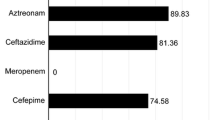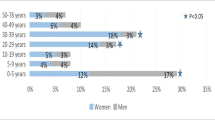Abstract
A collection of 201 Escherichia coli strains isolated from urine of patients in a Tunisian hospital between January 2006 and July 2008 was studied. Microbial identification was done by conventional methods, and antibiotic susceptibility with disk diffusion method was performed according to the Clinical Laboratory and Standards Institute guidelines. Detection of extended-spectrum beta-lactamase (ESBL) was performed by double-disk synergy test (DDST) and identification was done by PCR and sequencing. ESBL-producing isolates were subjected to molecular typing by random amplified polymorphic DNA (RAPD) and ST131 detection by PCR. Four phylogenetic groups (A, B1, B2 and D), 18 virulence genes and CTX-M group were individualized using PCR. Statistical analysis was done by Pearson χ2 test and Mann–Whitney U test. The strains were recovered primarily from urology (28 %), maternity (19 %) and medicine (16 %) wards. Antibiotic resistance rates were ampicilin (72.1 %), nalidixic acid (41.8 %), ciprofloxacin (38.8 %), gentamicin (23.9 %) and cefotaxime (17.4 %). Thirty-one of cefotaxime-resistant isolates (n = 35) had a positive DDST and harboured bla CTX-M-15 gene. Twenty of them (64.5 %) belonged to the ST131 clone and showed the same RAPD DNA profile. Ciprofloxacin- and cotrimoxazole-susceptible isolates were significantly associated with phylogenetic group B2, whereas isolates that were resistant to these molecules were associated with B1 and D phylogenetic groups, respectively. Virulence genes were significantly more frequent among ciprofloxacin- and cotrimoxazole-susceptible strains than those resistant to these antibiotics. However, CXT-M-15-producing isolates were associated with many virulence genes. Isolates concomitantly susceptible to the three antimicrobials agents (ciprofloxacin, cefotaxime and cotrimoxazole) were significantly associated with group B2 and high virulence score, whereas isolates with resistance patterns especially those including resistance to ciprofloxacin belonged predominantly to B1 phylogroup and haboured few virulence genes. The emergence of virulent and multidrug-resistant E. coli is a concerning development that deserves close attention in our institution.
Similar content being viewed by others
References
Bingen-Dubois M, Clerment O, Bonacorsi S, Terki M, Brahimi N, Loukil C, Barraud D, Bingen E (2002) Phylogenetic analysis and prevalence of urosepsis strains of Escherichia coli bearing pathogenicity island-like domains. Infect Immun 70:3216–3226
Branger C, Zamfir O, Geoffroy S, Laurans G, Arlet G, Thien HV, Gouriou S, Picard B, Denamur E (2005) Genetic background of Escherichia coli and extended-spectrum β-lactamase type. Emerg Infect Dis 11:54–61
Clermont O, Bonacorsi S, Bingen E (2000) Rapid and simple determination of the Escherichia coli phylogenetic group. Appl Environ Microbiol 66:4555–4558
Clermont O, Lavollay M, Vimont S, Deschamps C, Foresier C, Branger C, Denameur E, Arlet G (2008) The CTX-M-15-producing Escherichia coli diffusing clone belongs to a highly virulent B2 phylogenetic subgroup. J Antimicrob Chemother 61:1024–1028
Clermont O, Dhanji H, Upton M, Gibreel T, Fox A, Boyd D, Mulvey MR, Nordmann P, Ruppé E, Sarthou JL, Frank T, Vimont S, Arlet G, Branger C, Woodford N, Denamur E (2009) Rapid detection of the O25b-ST131 clone of Escherichia coli encompassing the CTX-M-15-producing strains. J Antimicrob Chemother 64:274–277
Clinical Laboratory and Standards Institute Guidelines (2008) Performance standards for antimicrobial susceptibility testing, 18th informational supplement, M100-S18. Clinical and Laboratory Standards Institute, Wayne
Drieux L, Brossier F, Sougakoff W, Jarlier V (2008) Phenotypic detection of extended-spectrum beta-lactamase production in Enterobacteriaceae review and bench guide. Clin Microbiol Infect 14:90–103
Johnson JR, Stell A (2000) Extended virulence genotypes of Escherichia coli strains from patients with urosepsis in relation to phylogeny and host compromise. J Infect Dis 181:261–272
Johnson JR, Kuskowski MA, Owens K, Gajewski A, Winokur PL (2003) Phylogenetic origin and virulence genotype in relation to resistance to fluoroquinolones and/or extended-spectrum cephalosporins and cephamycins among Escherichia coli isolates from animals and humans. J Infect Dis 188:759–768
Johnson JR, Kuskowski MA, O'Bryan TT, Colodner R, Raz R (2005) Virulence genotype and phylogenetic origin in relation to antibiotic resistance profile among Escherichia coli urine sample isolates from Israeli women with acute uncomplicated cystitis. Antimicrob Agents Chemother 49:26–31
Karisik E, Ellington MJ, Livermore DM, Woodford N (2007) Virulence factors in Escherichia coli with CTX-M-15 and other extended-spectrum β-lactamases in the UK. J Antimicrob Chemother 61:54–58
Lloyd AL, Rasko DA, Mobley HL (2007) Defining genomic islands and uropathogen-specific genes in uropathogenic Escherichia coli. J Bacteriol 189:3532–3546
Mahenthiralingam E, Campbell ME, Foster J, Lam JS, Speert DP (1996) Random amplified polymorphic DNA typing of Pseudomonas aeruginosa isolates recovered from patients with cystic fibrosis. J Clin Microbiol 34:1129–1135
Moreno E, Prats G, Sabaté M, Pérez T, Johnson JR, Andreu A (2006) Quinolone, fluoroquinolone and trimethoprim/sulfamethoxazole resistance in relation to virulence determinants and phylogenetic background among uropathogenic Escherichia coli. J Antimicrob Chemother 57:204–211
Pagani L, Dell'Amico E, Migliavacca R, D'Andrea MM, Giacobone E, Amicosante G, Romero E, Rossolini GM (2003) Multiple CTX-M-type extended-spectrum beta-lactamases in nosocomial isolates of Enterobacteriaceae from a hospital in northern Italy. J Clin Microbiol 41:4264–4269
Peiranoa G, Pitout JDD (2010) Molecular epidemiology of Escherichia coli producing CTX-M β-lactamases: the worldwide emergence of clone ST131 O25:H4. Int J Antimicrob Agents 35:316–321
Piatti G, Mannini A, Balistreri M, Schito AM (2008) Virulence factors in urinary Escherichia coli strains: phylogenetic background and quinolone and fluoroquinolone resistance. J Clin Microbiol 46:480–487
Ruiz J, Simon K, Horcajada J, Velasco M, Barranco M, Roig G, Moreno-Martínez A, Martínez J, Jiménez de Anta T, Mensa J, Vila J (2002) Differences in virulence factors among clinical isolates of Escherichia coli causing cystitis and pyelonephritis in women and prostatitis in men. J Clin Microbiol 40:4445–4449
Takahashi A, Kanamaru S, Kurazono H, Kunishima Y, Tsukamoto T, Ogawa O, Yamamoto S (2006) Escherichia coli isolates associated with uncomplicated and complicated cystitis and asymptomatic bacteriuria possess similar phylogenies, virulence genes, and O-serogroup profiles. J Clin Microbiol 44:4589–4592
Wiles TJ, Kulesus RR, Mulvey MA (2008) Origins and virulence mechanisms of uropathogenic Escherichia coli. Exp Mol Pathol 85:11–19
Acknowledgments
This work was supported by the Ministry of Scientific Research, Technology and Competence Development of Tunisia. E. coli CFT073 and E. coli J96 reference strains were kindly given by H. Mobley (Michigan, USA), E. Moreno (Barcelona, Spain) and U. Dobrindt (Würzburg, Germany).
Author information
Authors and Affiliations
Corresponding author
Rights and permissions
About this article
Cite this article
Ferjani, S., Saidani, M., Ennigrou, S. et al. Multidrug resistance and high virulence genotype in uropathogenic Escherichia coli due to diffusion of ST131 clonal group producing CTX-M-15: an emerging problem in a Tunisian hospital. Folia Microbiol 59, 257–262 (2014). https://doi.org/10.1007/s12223-013-0292-0
Received:
Accepted:
Published:
Issue Date:
DOI: https://doi.org/10.1007/s12223-013-0292-0




